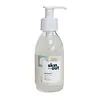What's inside
What's inside
 Key Ingredients
Key Ingredients

 Benefits
Benefits

 Concerns
Concerns

No concerns
 Ingredients Side-by-side
Ingredients Side-by-side

Water
Skin ConditioningDecyl Glucoside
CleansingPropanediol
SolventGlycerin
HumectantPolyglyceryl-4 Caprate
EmulsifyingXanthan Gum
EmulsifyingDisodium Cocoyl Glutamate
CleansingSorbitan Sesquicaprylate
Skin ConditioningAlpha-Glucan Oligosaccharide
CleansingZinc PCA
HumectantAloe Barbadensis Leaf Juice Powder
Skin ConditioningCalcium Gluconate
HumectantGluconolactone
Skin ConditioningSodium Cocoyl Glutamate
CleansingSodium Benzoate
MaskingWater
Skin ConditioningGlycerin
HumectantPentylene Glycol
Skin ConditioningErythritol
HumectantInulin
Skin ConditioningDisodium Cocoyl Glutamate 100%
CleansingCucumis Sativus Fruit Extract
EmollientZinc PCA
HumectantAloe Barbadensis Leaf Juice Powder
Skin ConditioningLeuconostoc/Radish Root Ferment Filtrate 100%
AntimicrobialDecyl Glucoside 100%
CleansingXanthan Gum 100%
EmulsifyingSodium Gluconate
Skin ConditioningLevulinic Acid
PerfumingCitric Acid
BufferingSodium Levulinate 100%
Skin ConditioningSodium Chloride
MaskingWater, Glycerin, Pentylene Glycol, Erythritol, Inulin, Disodium Cocoyl Glutamate 100%, Cucumis Sativus Fruit Extract, Zinc PCA, Aloe Barbadensis Leaf Juice Powder, Leuconostoc/Radish Root Ferment Filtrate 100%, Decyl Glucoside 100%, Xanthan Gum 100%, Sodium Gluconate, Levulinic Acid, Citric Acid, Sodium Levulinate 100%, Sodium Chloride
Ingredients Explained
These ingredients are found in both products.
Ingredients higher up in an ingredient list are typically present in a larger amount.
Aloe Barbadensis Leaf Juice Powder comes from the aloe plant.
You may know Aloe to be a good sunburn reliever and inflammation reducer. This is because it contains many components that are known to help reduce irritation and itchiness.
Aloe leaves are also great moisturizers. They are naturally rich in polysaccharides, a carbohydrate made of sugars. Polysaccharides are able to mimic the carbs found in the top layer of your skin. This can help keep your skin hydrated.
Aloe contains the antioxidants Vitamins A, C, and E. These vitamins neutralize free radicals. Free-radicals are molecules that may damage your skin cells, such as pollution.
Aloe does not protect against UV rays, despite it soothing sunburns.
Learn more about Aloe Barbadensis Leaf Juice PowderDecyl Glucoside is a glucose-based surfactant and emulsion stabilizer. It is created by reacting glucose with the fatty acids from plants.
Surfactants help clean the skin by trapping oil, sebum, and dirt to be washed away. As an emulsion stabilizer, it stabilizes the ingredients in a product by preventing them from separating.
This ingredient is biodegradable and non-toxic. This ingredient is commonly found in baby shampoos.
Decyl Glucoside is sometimes used to stabilize the UV filter Tinosorb.
Learn more about Decyl GlucosideWe don't have a description for Disodium Cocoyl Glutamate yet.
Glycerin is already naturally found in your skin. It helps moisturize and protect your skin.
A study from 2016 found glycerin to be more effective as a humectant than AHAs and hyaluronic acid.
As a humectant, it helps the skin stay hydrated by pulling moisture to your skin. The low molecular weight of glycerin allows it to pull moisture into the deeper layers of your skin.
Hydrated skin improves your skin barrier; Your skin barrier helps protect against irritants and bacteria.
Glycerin has also been found to have antimicrobial and antiviral properties. Due to these properties, glycerin is often used in wound and burn treatments.
In cosmetics, glycerin is usually derived from plants such as soybean or palm. However, it can also be sourced from animals, such as tallow or animal fat.
This ingredient is organic, colorless, odorless, and non-toxic.
Glycerin is the name for this ingredient in American English. British English uses Glycerol/Glycerine.
Learn more about GlycerinWater. It's the most common cosmetic ingredient of all. You'll usually see it at the top of ingredient lists, meaning that it makes up the largest part of the product.
So why is it so popular? Water most often acts as a solvent - this means that it helps dissolve other ingredients into the formulation.
You'll also recognize water as that liquid we all need to stay alive. If you see this, drink a glass of water. Stay hydrated!
Learn more about WaterXanthan gum is used as a stabilizer and thickener within cosmetic products. It helps give products a sticky, thick feeling - preventing them from being too runny.
On the technical side of things, xanthan gum is a polysaccharide - a combination consisting of multiple sugar molecules bonded together.
Xanthan gum is a pretty common and great ingredient. It is a natural, non-toxic, non-irritating ingredient that is also commonly used in food products.
Learn more about Xanthan GumZinc PCA (or "zinc salt") differs slightly from zinc itself. PCA stands for pyrrolidone carboxylic acid. However, Zinc PCA comes from zinc.
It can help reduce redness, regulate sebum, and promote the general healing process of the skin.
Zinc PCA tends to be especially useful for those with oily, acne-prone skin. It's certainly an ingredient worth trying out!
Learn more about Zinc PCA